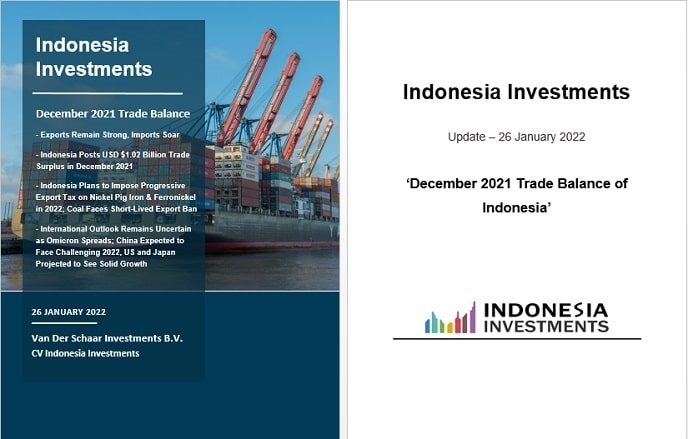Trade Balance of Indonesia: Exports Stayed High, Imports Surged Further in December 2021
On 17 January 2022 Statistics Indonesia (BPS) released the latest trade data of Indonesia. The data show that Indonesian exports remained high (near record-high territory) in December 2021, while imports into Indonesia even managed to set a new all-time record (with a huge jump in imports of raw materials and consumer goods suggesting that economic activity is strong, although this could be a temporary phenomenon in the context of Christmas and New Year festivities).
Overall, we can conclude that 2021 was a good year for Indonesia in terms of trade. Indonesian exports grew rapidly in 2021 on the back of rebounding global economic activity (that caused global commodity prices to skyrocket) after the intensity of the COVID-19 crisis eased, while imports needed a bit more time to recover. Moreover, considering there occurred an unprecedented drop in consumption, production and trade, demand for energy dropped accordingly in Southeast Asia’s biggest economy. Indonesia – which typically records a deficit in oil and gas trade – therefore saw its oil and gas deficit ease heavily since the outbreak of COVID-19 in early 2020.
In 2019 (‘pre-COVID-19-crisis time’) Indonesia imported an average of around USD $1.75 billion, per month, of oil and gas products. It is very interesting to mention that in the last two months (November and December 2021) Indonesia is – for the first time since the crisis – back at this level (with USD $1.69 billion in oil and gas imports in November 2021 and USD $2.28 billion in oil and gas imports in December 2021). This is something particularly worth following in the months ahead (to confirm that this apparent recovered energy import is not a temporary phenomenon only).
On the other hand, the normalization of Indonesia’s import performance also means that the monthly trade balance is bound to come under pressure. We already saw this happening in December 2021 when the country’s trade surplus reached USD $1.02 billion ‘only’, which is the weakest monthly surplus since April 2020.
Overall, in full 2021, Indonesia’s trade balance surplus was very impressive at USD $35.34 billion, which subsequently supported the country’s current account balance and the rupiah exchange trade.
[...]
Read the full article in the January 2022 report. This report can be ordered by sending an email to info@indonesia-investments.com or a message to +62.882.9875.1125 (including WhatsApp).
Price of this (electronic) report:
Rp 150,000
USD $10,-
EUR €10,-

